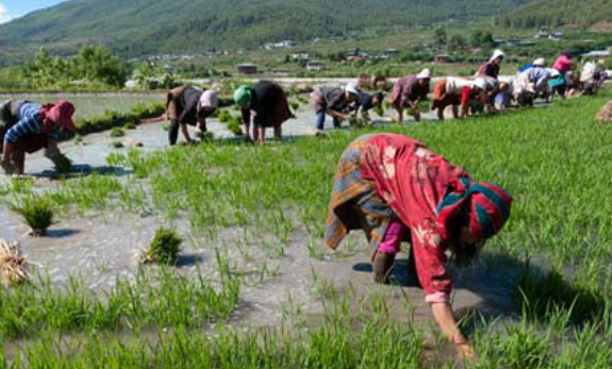Agency: Bhutan has set its sights on doubling its GDP from USD 2.5 billion (bn) to USD 5 bn by 2029, and the Ministry of Agriculture and Livestock (MoAL) is positioning the country’s farms at the center of this transformation. With an ambitious plan to triple agricultural exports from Nu 3 bn to Nu 9 bn by 2034 MoAL is rolling out a mix of modern technology, entrepreneurship support, and international market linkages to boost farm productivity and food security.
Officials acknowledge that complete food self-sufficiency will remain difficult given Bhutan’s geography and workforce challenges, but the strategy emphasizes a balance between increasing domestic production and building resilience against imports. The guiding frameworks include the Food and Nutrition Security Policy 2023, the Agri-Food Strategy 2034, and the 21st Century Economic Roadmap all designed to make farming more modern, competitive, and market-driven.
A major push is underway to mechanize Bhutanese farms. From power tillers and combined harvesters to smart farming systems like hydroponics and precision agriculture, farmers are gaining access to tools that reduce labor shortages and attract younger generations to agriculture. In just the past year, 416 power tillers were distributed in eastern Bhutan, while over 300 greenhouse sets and more than 1,500 irrigation systems were installed nationwide on a cost-sharing basis.
The ministry is also targeting value addition and agribusiness growth to reduce post-harvest losses and raise export quality. Sixteen new agri-food enterprises have been supported with modern processing and packaging facilities, ranging from tofu processing plants to freeze-drying equipment, helping farmers diversify products and tap into premium markets.
To strengthen market access, 65 farmer groups and cooperatives have been directly linked to institutions, while new trade routes are being opened. Bhutanese outlets are already operational in Guwahati and Siliguri, with future plans in Thailand and other hubs. Meanwhile, a recent launch in Malaysia introduced “Whollistic Plus, Age Joyfully,” a wellness product made from Bhutanese turmeric, ginger, and ganoderma, highlighting how local ingredients are being transformed into high-value exports.
Special attention is being given to niche commodities like mushrooms, rainbow trout, honey, and yak cheese, with the government introducing a Geographical Indication (GI) system to build brand recognition. Books of Specification have already been developed for products like buckwheat and yathra textiles, strengthening Bhutan’s position in global specialty markets.
By combining modern farm practices with strong export orientation, MoAL hopes to raise farm incomes, secure nutritious food for households, and make agriculture a cornerstone of national prosperity.
“The goal is not just self-reliance in food but also turning agriculture into an engine of economic growth,” officials noted.

